Originally recorded on Thursday, June 20, 2025. The full broadcast of the 2025, 51st Annual Ken Roberts Memorial Delineation Competition is available now online. Click the “Play the Video” button to watch the recorded broadcast.
You can read part 1 of the announcement transcript in the post below, or click on an image to go directly to the juror commentary in the transcript for that winning entry.
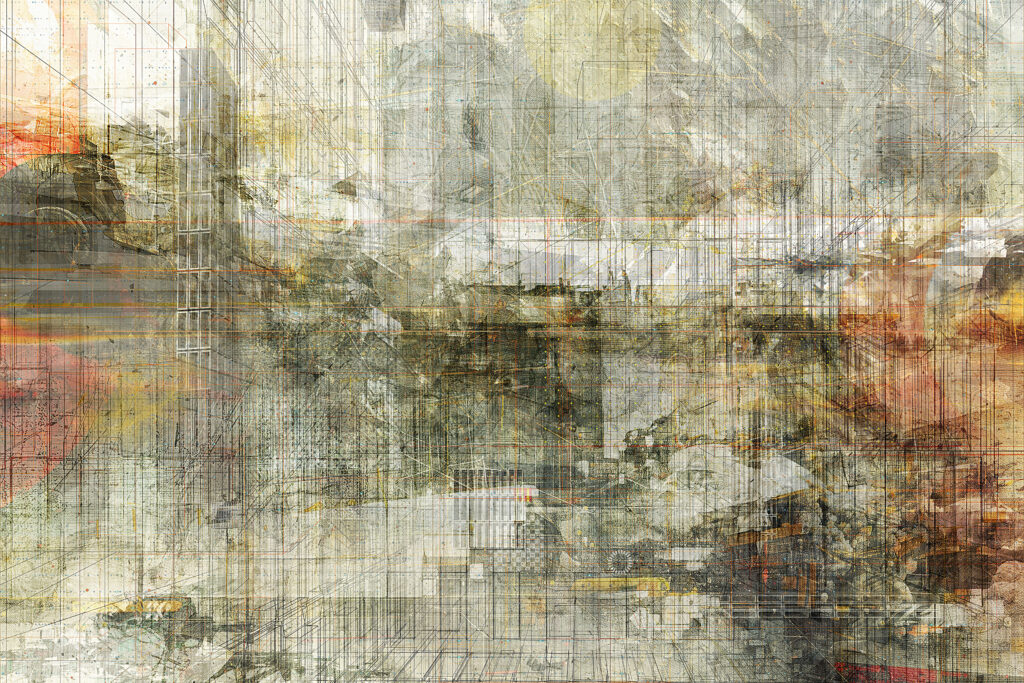

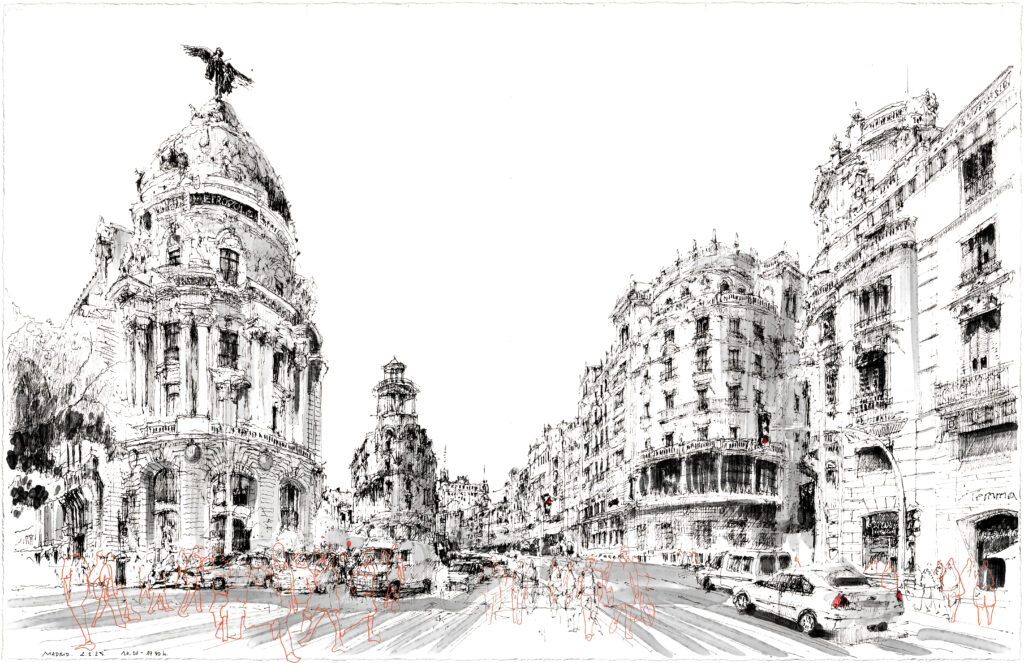
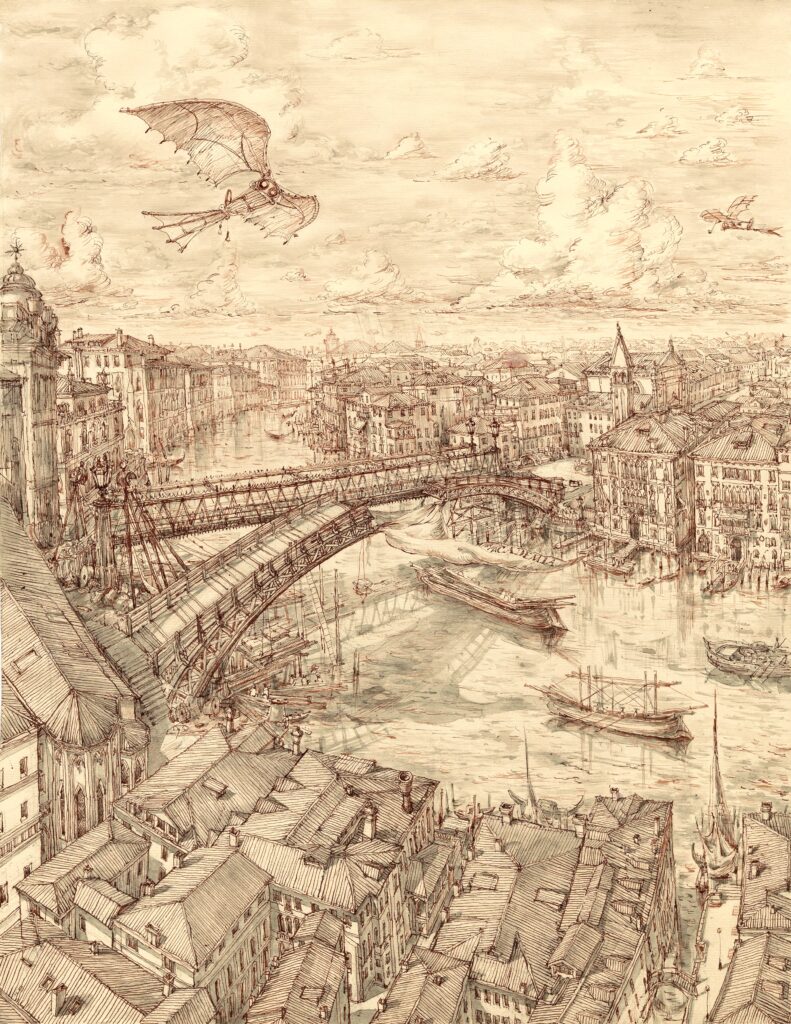

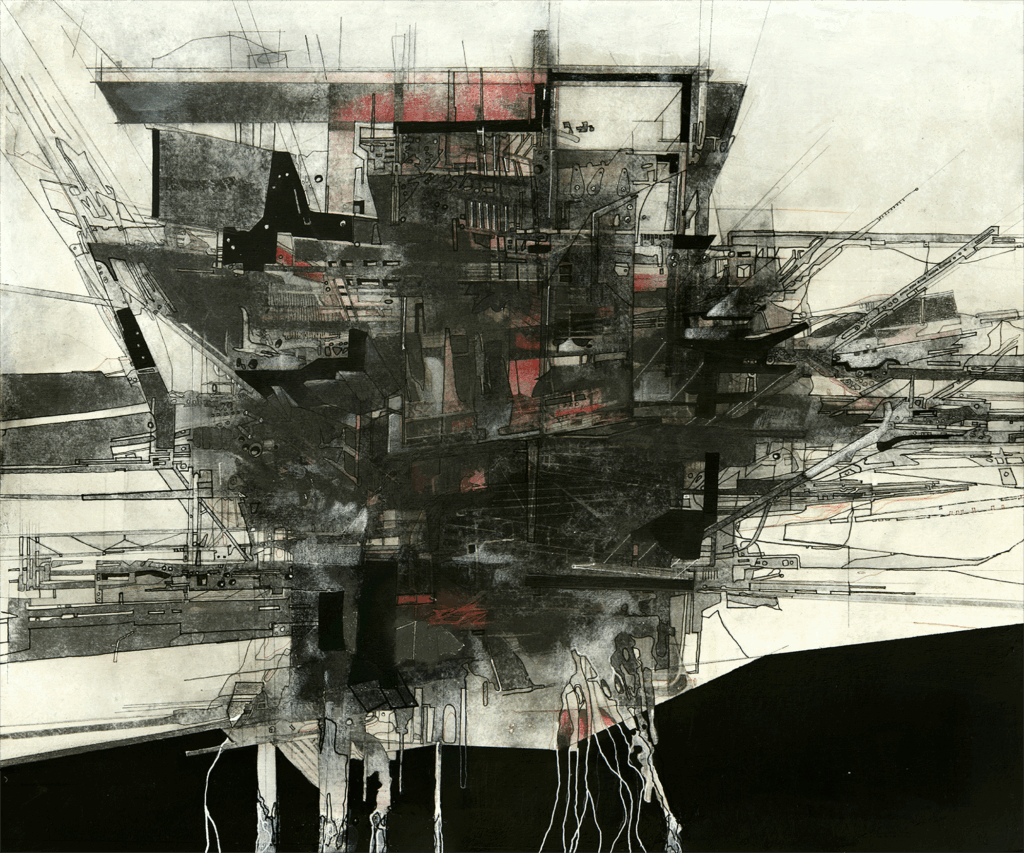
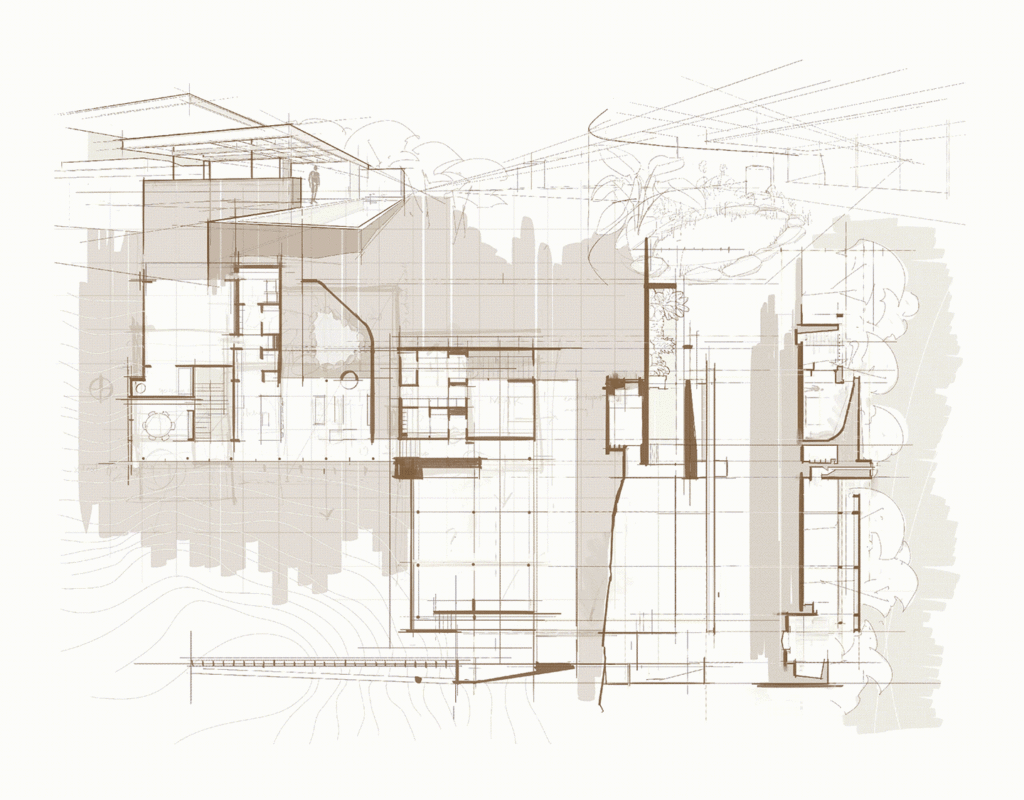
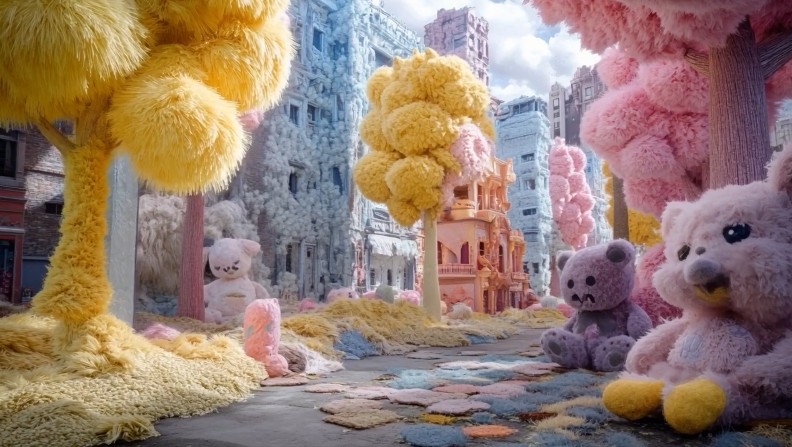
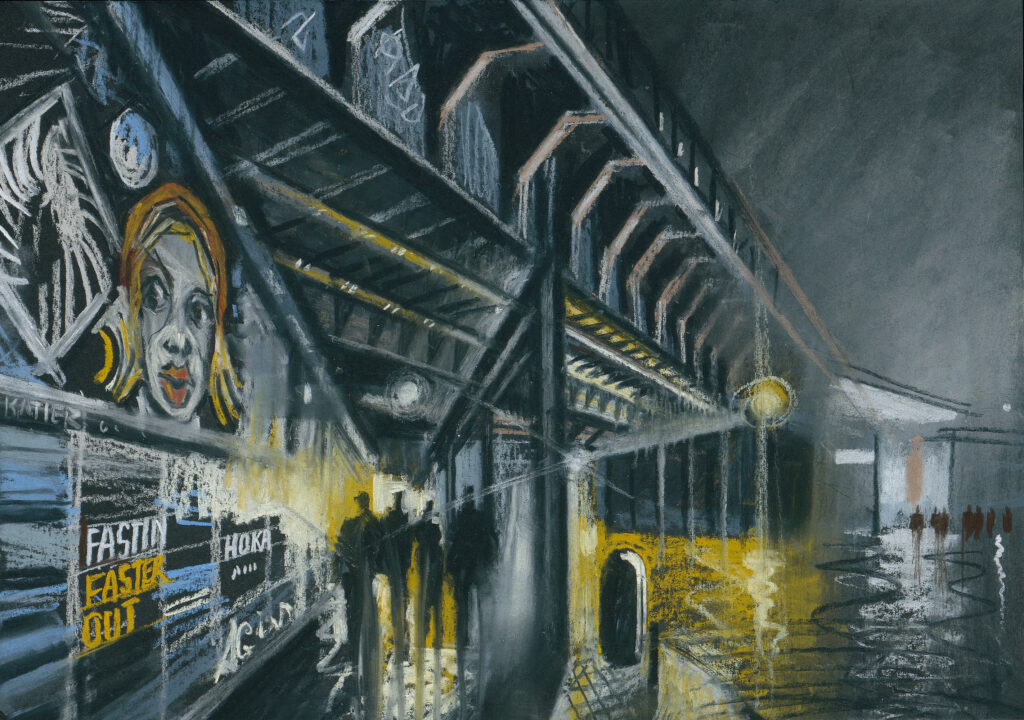
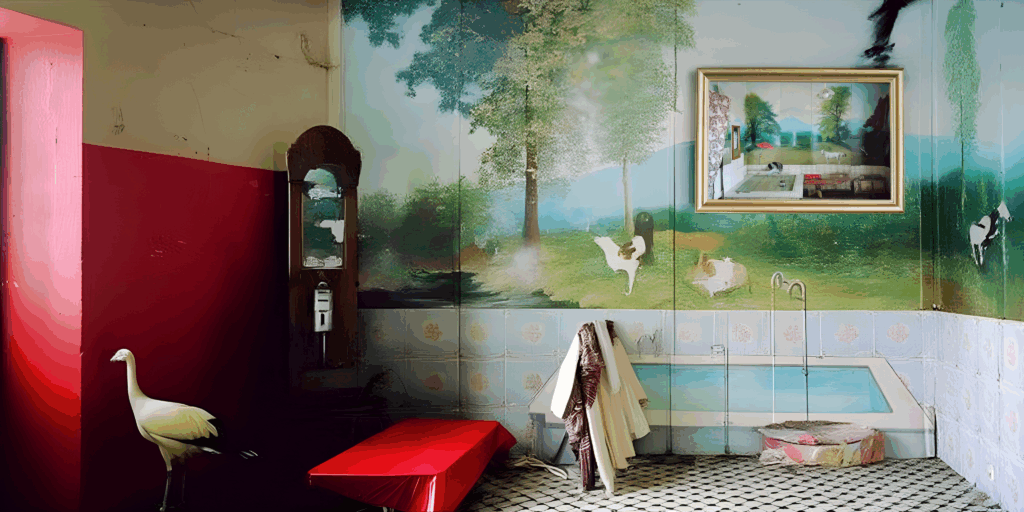
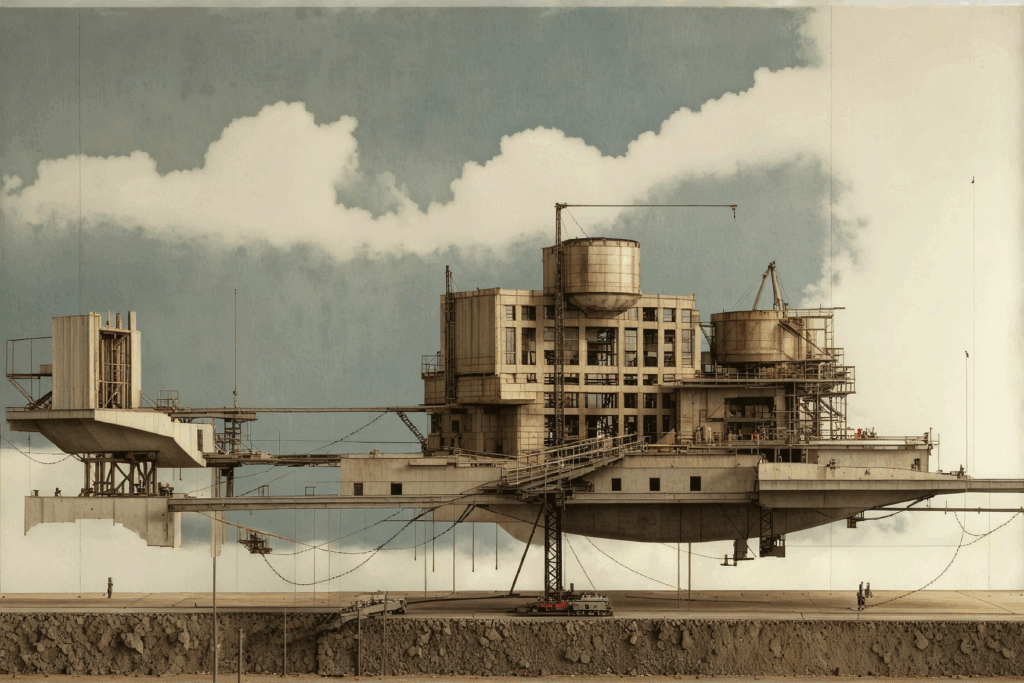
Zaida Basora, FAIA: Good day and good evening, everyone. I am Zaida Basora, Executive director at AIA Dallas. It is my distinct pleasure to welcome you all to the 51st Annual Ken Roberts Memorial Delineation Competition Announcement. That is indeed a mouthful, but KRob, as we dearly refer to it, carries a legacy of excellence. We are pleased to have with us today, Anthony Montalto, AIA, Chief Design Officer and EVP at HKS, our presenting sponsor. Thank you, Tony, for being here.
Anthony Montalto, AIA: Thank you.
Zaida Basora, FAIA: Today we’re honored to have a stellar panel of jurors and an equally impressive and inspiring collection of award-winning works of architectural delineation. As we celebrate this 51st anniversary, we are reminded of the remarkable sustainability of this competition, a true testament to the enduring legacy of drawing and the vital importance of visualization in architecture and design. Year after year, architects and designers use this platform to fuel their passion for design, express bold ideas, explore new possibilities, and engage with the rich visual language of our profession.
We recognize and celebrate the evolution of media and the innovative approaches our community uses to share and convey design ideas. This competition continues to push the boundaries of what architectural delineation can be. Thank you all for joining us as we announce this year’s winners.
Before we begin, I would like to extend my deepest gratitude towards our sponsors. Their support is essential to the longevity and success of this event. Thank you to HKS, a dedicated sponsor of this competition for well over a decade, and our presenting sponsor for the past seven years. Tony, you had a few words to share before we proceed.
Anthony Montalto, AIA: Thank you, Zaida, and good day everyone. On behalf of all of us at HKS, I’m honored to welcome you at this year’s Ken Roberts Memorial Delineation Competition. A celebration, not just a visual talent and technical skill, but of the enduring spirit of architectural storytelling. For decades, KRob has recognized drawing as more than a representational tool. It is a language of intention, exploration, and imagination in every era of architecture. From handwritten perspective to digital dreamscape, the power to visualize has shaped our ability to envision the future before it’s built. This competition carries that legacy forward. At HKS, we believe design excellence begins with fearless curiosity and bold communication. And drawing in all its forms is the medium that brings our ideas to life. We are proud to stand with AIA Dallas and continuing to elevate this important tradition. I want to extend a special thanks to Zaida Basora, FAIA for her leadership at AIA Dallas, and for continuing to champion this important platform for dialogue and creative expression within our profession. Whether you are submitting work, serving as a juror, or attending to be inspired, your participation affirms that drawing remains a powerful force in shaping architectural culture. It connects generations, challenges, conventions, and ultimately helps us all see more clearly what’s possible. Thank you for being part of this year’s KRob. We’re excited to celebrate the craft, the innovation, and the legacy of delineation with you.
Zaida Basora, FAIA: Thank you, Tony, for your inspiring words. We also want to thank our Gold Sponsors, Corgan, who is producing and broadcasting this event, and Page/. Our Silver Sponsors, Form Metal, Gensler, and Pella, and Orchestration, for their in-kind sponsorship. Thank you, Jeff, for all you do for us, and thank you to all our sponsors.
I would also like to invite you all to come to the Architecture and Design Exchange on July 14th to the gallery opening party of the KRob Exhibition. The exhibition will open July 8th and will run through August 16th. Now, before we bring in Selena and Ryan, our Kro co-chairs, let’s take a look at some work from HKS.
Selina Cinecio, AIA: Thank you. Good afternoon. My name is Selina Cinecio, and alongside me is Ryan Playle. We’ve had the privilege of serving as chair and vice chair for the year 2025, bringing with us over seven years of dedicated service on the KRob committee. Today, we gather to celebrate excellence in architectural drawings and illustrations, a longstanding tradition in Dallas and renowned for its international acclaim.
This year marks the 51st anniversary of the KRob Awards, and we are thrilled to announce that we received an impressive 325 entries from around the world. These submissions showcase exceptional talent from both students and professionals alike. Out of these entries, our esteemed jurors have selected eight winners who will each receive a cash prize, in addition to recognizing three entries with juror citations. The works of our finalists, totaling fifty-six this year, will be prominently displayed on our website and in our annual gallery exhibit at the Architecture and Design Exchange in Downtown Dallas. We are truly impressed, not only by the quantity, but by the amazing quality of the submissions. We are eager to present this year’s deserving winners.
We also extend our heartfelt gratitude to everyone who has contributed to our committee this year, as well as to Josh Mason, Maddie Melton, and Ricardo Leon for their continued efforts on the 50th anniversary book. We are looking forward to its release later this year. With that, I will now pass the floor to Ryan to introduce our moderator for this year’s event. Thank you.
Ryan Playle: Thank you, Selena. It’s my honor to introduce Josh M. Nason as Dean of Hammond School of Architecture at Drew University and our moderator for this event. Josh directs the Experimental Design Research Collaborative Iterative Studio, educated at Texas Tech and Cornell University, Professor Nason teaches courses in architectural design, making, mapping, urbanism theory, and design-build. For Nason, teaching is cultivating a series of experiences that helps students realize their authentic potential to impact the built world. Nason works across a variety of mediums, including writing, drawing, and building, all of which he considers acts of architecture that mediate between people and places. With Jeffrey Nesbitt, he edited “Chasing the City: Models for Extra Urban Investigations” and is featured in the Nature of Enclosure podcast and book in-kind. Mason is helping to edit the forthcoming book, “KRob at 50” and is hosting and producing, Drawing Conclusions, a podcast investigating pressing questions of architectural representation. Joshua’s exhibited and published designs and research explored dynamic connections, relationships, and reciprocities in architecture, landscape, and urban projects. Looking specifically at the inherent duality within the representation of people in place, designs the narrative connective and advocative potentials. His drawn and built work has been in featured in exhibitions such as Divergent Convergent Speculations on China, in Beijing, Common Ground in New York City, profiling a city in Ithaca, and the Place Pavilions in both Lubbock and Dallas. This live broadcast is available courtesy of Corgan Media Lab. Thank you for your support. Before we bring in Josh and the panel, let’s take a look at some work from Corgan. Thank you.
[A diverse group of creatives from every corner of the globe, responsible for gateway destinations on three different continents and some of the biggest data infrastructure in the world. Our designs are visited by millions a day, creating environments where children learn and businesses thrive. Our buildings are a destination for health and wellness. We’re researchers and futurists, curious and creative, passionate and dedicated. We are Corgan.]
Joshua M. Nason: Hello, good afternoon. Welcome to this wonderful media lab space at Corgan. We want to thank their team for all of their help and support in this and also HKS and all of our sponsors. Thank you so much for making KRob a possibility. This is, as Selena mentioned, the 51st year of this tremendous competition. The work that’s been gathered is incredible. It’s going to be so much fun to sit here and talk with my colleagues about this work. It is the summer solstice. It’s the longest day of the year. We can stay here as long as we want. We’re going to burn all this daylight. Now I want to pause for just a second for an important announcement. My twin sons’ birthdays are today. Happy birthday, Dallan and Carter. I just wanted to make you feel super uncomfortable right here at the outset. Thank you, Ryan and Selena, for that lovely introduction. I really appreciate that. In a second, I’ll talk about my work but want to mention that if you are watching this through Vimeo, the comment section is open. We won’t see those on the panel, but please share congratulations and messages of joy and talk about this wonderful work, but also the power and the emphasis that architecture can put out there and that drawing and delineation can do as well. Thank you, AIA Dallas, for starting this 51 years ago for being a champion of delineation and of creative work. This is an awesome honor to be here and be a part of this, and we thank you for all of your hard work.
Now to talk a little bit about my work—my work is an exploration of processes and of potentials. For me, medium is in flux. I like to work across mediums, from writing and drawing, to building, and as many ways as I can in between. I think that architecture is inherently a series of devices and things and implements that mediate between people and place. And for me, a good written piece or a drawing is as much architecture as anything else. I don’t say that to degrade what a building is—buildings are remarkable, but as we talk about these drawings today, I just want to emphasize that to me, these are pieces of architecture. These can have impact in the world. They can make the world a better place. They can open our minds and challenge us to think of new things. And we want to put ideas into the world that help the world be as good as it can be. Thank you for this opportunity and thank you for this chance to talk about this great work.
To let you all know our process today, we have eight category winners that we’re going to announce. In just a second, I’m going to turn it over to the jurors, and each of them is going to take turns, one at a time, talking about these eight category winners. The categories vary quite a bit. From the initial conception of the competition, there has been an emphasis on hand drawing, travel sketching, and physical submissions, but we recognize that drawing and representation has evolved. Over the years categories have been added, like digital and hybrid media, which is an important part of our discipline as well, and a reconfigured category this year that is now called “alternative technologies” and a new one in process visualization. As we go from the hand sketch and the hand drawing to physical submissions, to digital hybrid, to things that involve AI, to methods that include processes that challenge us and teach us, it’s just a great opportunity to talk about what we make, what that means, and all the possibilities. We’re really looking forward to talking about those eight categories. After which we’re going to have three juror citations where each juror picked a project that they find particularly compelling. We’ve got about an hour and a half of tremendous work to look at and conversations to have, and it’s really exciting to be here.
Let me start by introducing our jurors. The first juror I’d like to introduce is Brad Bell. Brad is the former director of the School of Architecture and an associate professor at the University of Texas at Arlington. Since 2014, he has directed the Digital Architecture Research Consortium at UT Arlington. That’s a group of industry and academic partners working on integrating advanced digital technologies and material applications into innovative building solutions. Most recently, he co-authored the book “The Evolution of Computation and Architecture” with Michael Fox. This book provides one of the first comprehensive examinations of the six stages of computational integration in the architecture design process. Professor Bell was awarded the UT Arlington President’s Medal for Teaching Excellence in 2015, and the Texas Society of Architects awarded him with the Outstanding Educational Contribution in honor of Edward J Romanek, FAIA. He’s also received a Citation of Honor for his leadership in helping to establish the nationally recognized design build program at UT Arlington.
Our next juror is Ursula Emery McClure, FAIA, and just about every other letter you can imagine in her accolades. I teased her earlier that she’s an alphabet collector because when you see these wonderful accomplishments, it’s quite impressive and across disciplines. She’s a founding partner and the head of Emory McClure Architecture and currently serves as a transdisciplinary design professor in the Staley School of Leadership and the GE Johnson Department of Architectural Engineering and Construction Science at Kansas State University. Located somewhere between the global petrochemical infrastructure, alligators, and most recently, some buffalo, Emory McClure architecture practices to create the unexpected from the common, through an inclusive philosophy that uses design to resolve opposing forces, the firm develops solutions that are unique, yet familiar, ideal, yet accessible, practical, yet poetic. Its work strives to celebrate, uncover, and make more vivid the cultural, environmental, and social context of each project. Her architectural practice and research have garnered numerous awards, publications and exhibitions, including the Gorman P Stevens Rome Prize for Architecture, multiple American Residential Design Awards, and appearances at the Venice Biennale, among others. She was named one of ArchDaily’s most innovative practitioners in 2018 and was elevated to Fellow of the American Institute of Architects in 2022. Her most recent honor is the 2024 Award for Distinction from the Sam Fox School at Washington University in St. Louis. Her previous teaching appointments include the University of Texas at Arlington and Louisiana State University. Thank you for being here, Ursula.
Our next juror is Gregory Ibañez, FAIA. In an era of ever increasing specialization, Greg practices architecture as a generalist, a 1980 graduate of the Illinois Institute of Technology, he has developed an approach that is driven by program and characterized by formal restraint, frank and inventive detailing, and an abiding reverence for the experience of the occupants. Greg is a recognized design leader and a passionate advocate of progressive architecture within the profession and the community. The recipient of 31 AIA local and state design awards. Greg was elevated to the AIA College of Fellows in 2012. He was previously chair of the Fort Worth Public Art Commission and is a long-time board member of the Modern Art Museum of Fort Worth. He served on numerous AIA design award juries and is a board member of the Texas Architecture Foundation. He’s currently an adjunct professor at the University of Texas at Arlington School of Architecture, has been a guest speaker for the Dallas Architecture Forum, the Modern Art Museum of Fort Worth, and the Texas Society of Architects Convention. Thank you, Greg, for being here.
It’s really a great chance to be here with these three esteemed architects and teachers and to talk about some really, really remarkable work. I’m going to turn the time over to our jurors to go through these eight categories, starting with Brad.
Brad Bell: Thanks, Josh. I want to start though by saying again, thank you to the KRob committee, to the chairs, and to the longstanding history and importance of this competition. It’s been an honor to be invited to participate this year and to also serve with my esteem colleagues. My work, more than anything, has been marked by my investment in architectural education. I would say that over the last 25 years, that’s probably been one of the most fulfilling and rewarding aspects of what I do, who I am, and how I see design in the world around us through the ever increasing opportunities to reach students, to be with them as light bulbs go off and they begin to explore their own design process.
Being creative, we also know that it’s communal. I would echo Josh’s sentiments that all of the work —whether it’s material exploration, it’s installation, it’s a book, or it’s working with clients—is a communal act. For me, that is at the center of what of and has always excited me about what I do. More specifically, I work within the domain of digital technology, material science, and computational fabrication. I think that has characterized a lot of what I have invested in the last number of years. In that regard, I’m a little antithetical to the way we typically think about judging a competition like this, but it was mentioned earlier that representation and delineation has taken on a multifaceted way of being constructed and vetted. And it’s as digital as it is material at this point. We begin to understand it through an entirely different lens.

With that, I’m going to start us off with the first announcement for the Award for Excellence in Digital/Hybrid Media in the professional category. This award goes to Anton Markus Pasing. He is a professor at the University of Applied Science in Dusseldorf at the Peter Burns School of Arts. What we found compelling about this particular piece is that it begins to come alive. The depth of the piece oscillates depending upon your proximity or your scale to it. It is, as the artist described, cross media, or a hybrid display of techniques that pull you in to understand different ways of representation. Whether it’s one point perspective, collage, the use of color, or the fragments of narratives, usually dealing with the urban context, that allow us to be drawn in. Pasing identifies that for him, it’s through this layering that he looks for a combustible cross mix of social, technological, and the built environment to be called into question. As we studied this and got into the depths and the layers of what was being presented, we were all very taken by the intensity of it and the effectiveness of that intent. Congratulations to Professor Pasing.
Ursula Emery McClure, FAIA: I have the honor to speak about the next award, but before, so I will speak a little bit about the firm of Emory McClure Architecture. I will never speak as eloquently as the bio that Josh just read. I didn’t write that. My founding partner and husband, Michael McClure wrote that, and he’s way more scholarly than I am. So, I’ll speak more to the other side of the firm that Sarah, my other partner, and I work for, which is the joy and happiness that we take into the practice. One of the things that we love so much in Emory McClure Architecture is that every project that comes our way, be it a built work for a private client, a residence, a small commercial project, or a competition, that we enter to our breath of fresh air, as we like to say, and refresh ourselves. We always approach with the ability to make each other laugh, to find the humor, and even to make fun of ourselves. And the reason is, is that the role of the built environment is so critical and important to everyone and has so many aspects to it, that if you cannot always see what makes it work and what makes it great and what makes it an enjoyable experience, you’ll forget that it has so much relevance. We work very hard to do that in our firm. It is at the core of what we do, and we like to say to each other, if we didn’t at some point think that we were ridiculous, then we haven’t done our job well.

And with that, I get to start with an award that someone might think is a bit ridiculous and fantastic, the Award for Excellence in Digital/Hybrid Media for a student. The winners are Molly Rice and Abby Mud from the School of Art at the Institute of Chicago. And well, this is a fantastic piece of work. The students here are very clear in their intention. What is so wonderful about this entry is its clarity in the fact that it is a digital/hybrid mix. These six panels, each about 16 by 20 inches, are composed of paper layers that have imprints upon them—hand drawn, digitally drawn, and/or photo collage—and then layered upon that, pieces of material that have been cut to give a slight three-dimensional quality to each panel.
The jury was so impressed with what these images were, because at first, from afar, we all celebrated, as we are all practicing architects, in the joy of the section and the explicit nature of the section to give you technical depth and information about something that is constructed in the built environment. Simultaneously, we were impressed with the storytelling. Much like a storyboard for a film, this is a storyboard of a project. It gives you all of the insight into what it would be like in this place, traveling through this place, or looking at this place.
Finally, one of the coolest things is the fact that you can see the t-pins and the push pins that mounted this so that they could take the photograph that we see now in front of us. And also troll bones printed on paper, thrown across the top. You’ll never be able to see those here on the screen, so please take a moment to go look for some troll bones that identify this project. And now Greg, we’ll talk about his work.
Gregory Ibañez, FAIA: Thank you, Ursula. First of all, I will echo the sentiments of Josh and my fellow jurors in thanking the KRob Committee, the sponsors, and AIA Dallas for running the most well organized, despite our efforts, competition that I’ve been a part of. It is a singular pleasure to sit on this jury for this most esteemed competition.
A little bit about our firm, Ibañez Shaw Architecture is a small firm located in Fort Worth, Texas in an at least 80-year-old auto repair shop. We’re a small practice. We were formed in 2017 by the merger of two congruent firms, mine, and Bart Shaw. Bart, my partner, is supremely talented and an unbelievable collaborator. Together we hope our firm, along with our staff, which we’re lucky to have and nothing would be accomplished without them, we hope we achieve more than the sum of the parts. We’re architects, and we mean that in the classic sense. We’re proud practitioners. We build things. We like to see things built. The only way we can achieve the work that we do is by a deep understanding of the construction and material process. If we’re lucky, we can sometimes elevate common materials to a higher level of architecture. We do projects of many sizes. No matter the size, we approach them the same way with an incredibly immersive interface with our clients. The ones that savor that and enjoy it, which luckily, we have some, makes for such a meaningful process. We are optimistic pragmatists, so we take on projects with difficult budgets often. Sometimes we get lucky, and we get something that’s a little more expansive.

With that, I have the great honor to announce the winner of the Kevin Sloan Award for Best Travel Sketch. This goes to Josep Eixerés Ros of the Universitat Politècnica de València. This sketch embodies the spirit of the late, much lamented and missed Kevin Sloan, for which this category has been named. Kevin had an energy and a passion for documenting places in the urban fabric on site. This sketch does that. It is an amazing balance between blending precision with spontaneity. It is balanced between gestural emotional drawing, but yet it is representational. We know where we are. It tells us. It makes us feel like we’re there. It is incredibly detailed yet not overworked. The perspective, the way the detail becomes more diffuse as the drawing recedes into space the same way our eyes see it—at least mine do without my glasses. The red people, or ghost people as we call them, are an inspired choice. This is a drawing that we were unanimous in praise for, and one that I really wish I had done. Thank you.

Brad Bell: Thanks, Greg. Now we go on to one of the longest standing categories for this particular competition. It’s named the HKS Award for Excellence in Hand Delineation in the professional category. This award this year goes to Nataliya Eliseeva, an architect, interior designer, and artist living in Moscow. What drew us to this particular piece is it’s actually quite intimate. It’s only about 17 inches by 20 inches in terms of its scale, and yet the amount of detail that has gone into it, the very specific selection of the composition, and the methods drew our attention, our focus, and influenced our way of discussing this piece in terms of just how elaborate it was. It’s based off the Academy Bridge in Venice—it’s titled The Two Bridges—which dates back to a point in time when this actual wooden bridge was constructed and then torn down in the early part of the 16th century. For us, it captured a certain moment in that process of construction. The reference to the Leonardo flying machine. The use of the tinted paper and brown ink with the wash. All of these things captured a moment in what the author describes as architectural fantasy, one that balances us between the thing that has happened and the thing that has yet to happen. It embodies that in a way that draws us in and confirms that intimate quality that we saw in the hand delineation of this particular piece.

Ursula Emery McClure, FAIA: The next award is the HKS Award for Excellence in Hand Delineation by a student. If you’ll notice, if you watch this entire show, I get to do all the student awards. I fought for that amongst my peers here because students always bring to the table something that is just beyond all of our imaginations. And the winner here has done that with amazement. Jason Wang, from the Bartlett School of Architecture, congratulations! You are the award winner of this prize. Colleagues in design schools often talk about “oh, no, students can’t draw anymore. They can’t use their hand. They don’t know how to do anything. They can’t even write their own name in a way that I can read it.” Well, Jason can do that, and Jason does it well.
This drawing, quite large in scale, of a fantastical maritime world where pieces of ships and military machinery have been cut into a magnificent hydrofoil section shows the precision that a student learns in design school in the art of drafting. And so, yes, in the contemporary realm, a student can still pick up a pencil and draft. But what makes this drawing even better, is the fact that beyond the precision of this imagined realm, we see the mess of drawing and the imagination that comes when one is working on the same piece of paper, losing control of their media, and expressing story after story after story. Each one of the little rooms, or alcoves, has something going on that doesn’t necessarily relate to its neighbor. Maybe it does. We don’t know. We want to know. We wish that there had been annotations on this drawing so that we would’ve known, but instead, it is left to our own imagination what everybody is doing all day inside of this hydrofoil. When I say “doing all day,” I am quoting from the books by Richard Scary, “What Do Busy People do all Day?” Richard Scary used to cut these beautiful drawings of things in machines in a way to teach one how the world works, be it a road or a car. This drawing is straight out of that legacy. I have such joy when I talk about it, as did the jury, because it is everything we want when a student picks up a pencil or a crayon or a charcoal to draw—to have them imagine and work until they have just left everything on the page.

Gregory Ibañez, FAIA: Thank you, Ursula. I have the pleasure of announcing the winner of the Richard B. Farrier Award for Best Physical Delineation, and the winner is Alejandro Borges, AIA from the College of Architecture at Texas A&M University. The title of this award is very important. It is a physical submission, which of course, through most previous competitions was the only way projects were judged. Being with this piece was not just physical, it was visceral. This is a drawing that was mixed media, hand drawing, graphite ink, acrylic, and watercolor on Strathmore paper mounted to board. And when you see it in person, you can see the layers. The use of black as a tonal method to create space, to preserve light, to pull you in—it’s a high wire act because it can immediately go to mud, but this doesn’t. There is an excellent photograph of this drawing online, and I urge you, as you’re seeing now, to look closely at the way the space is created, the moodiness, the way the line work goes from positive black on white to negative white on gray or black. Very judicious use of color in a subtle way but that activates the entire drawing. This is a wonderful piece. It creates space in two dimensions. It engages our imagination. From a design perspective, it’s a notable composition. It’s also a section. I think we all agree, this was an exemplary piece of work. Congratulations.

Brad Bell: The next category is the Award for Excellence in Process Visualization. As Josh mentioned, this is a new category and one that captures this particular moment in time in terms of how we think about process and record it through the delineation methods and means available. It’s my honor to congratulate Professor Dustin Wheat, AIA from the University of Texas at Arlington, who this year took a unique approach to how this particular category was tackled.
We saw iterative, we saw things that we highly technical, but one of the unique aspects that set this apart for us as a jury was to see the animated GIF in a way that that revealed the process itself. Using Adobe Suite and its many different facets, Professor Wheat started with about 1800 layers and had to reduce that down to roughly over 100, so there’s a curatorial process. What tells that story and what accomplishes clarity in how this particular sequence of drawings is assembled. We see in the layers and the successive aspects, there are moments where it’s sketched, it’s erased, it’s added back in, it’s locked in relative to the precision of the delineation. Then, it’s added upon, in terms of the section. We also see elevation aspects that get added as well. Ultimately, the idea of adding the perspectival layer as the way that we see the final culmination of this particular process. Congratulations to Dustin Wheat, especially as the inaugural recipient of this particular award.

Ursula Emery McClure, FAIA: Finally, the last award is the Award for Excellence in Alternative Technologies, which as a title means anything could be in here. And that’s what happened. We got everything and everything was fantastic.
The winner of this award, a student again, is Emily Dross from Ball State University. Everyone who’s watching this, you need to go to the webpage to watch this film and zoom in. This film—composed of AI technology, film technology, editing technology, and sound technology—is a masterful imagery of the future that we all are discussing as we think about where do we go with what we now possess.
This film goes from nightmare to daydream, to cotton candy, to the carnival, and back again, over and over. We were amazed at what was going on, and we kept saying, “wait, how is that happening? I’m disturbed. Oh my gosh, is this a snuff fluff film or a fluff snuff film?” It’s quite traumatizing, but it’s fantastic. It deserves to enter film competitions, because it’s so clever and expressive and explicative.
The fluff is amazing. It is constantly transforming from building to bear, bear to building, to subway, to multiple bears. Emily, congratulations. That’s all I have to say. We could not be more horrified, yet amazed simultaneously, and we will keep talking about this for a very, very long time.
Joshua M. Nason: Thank you, Ursula. From disconcerting bears to troll bones to ghost people to Leonardo’s flying machines—that pretty much sums up what we’ve seen so far. But we’re not done yet! Stick around. After we’re done with the last juror citations, we’re going to have a panel discussion where we talk about some specific pieces, but also some larger issues with drawing and architecture representation, and what that means for us going forward. Then there will be a scrolling through of finalists and entries that you definitely don’t want to miss.
First, we’re going to do some juror citations. I mentioned earlier, each juror gets to pick one project from anywhere in the category. These are usually projects that did not win another award but are highlighted for some very specific reason—something that was compelling, something that was inventive, something that was remarkable for each individual juror. Greg, why don’t we start with you?

Gregory Ibañez, FAIA: Thanks, Josh. My citation goes to Sergei Tchoban of Tchoban Voss Architekten GMBH in Berlin. On a personal level, I did a double take when we were reviewing. I was in Berlin for the first time earlier this year, and I stayed in a hotel that was a hundred meters from this underpass. I visited the train station, viewed in the distance on the right. I walked under that. Then recently, in fact closing this weekend, is a wonderful exhibit at the Kimball Museum in Fort Worth of masterworks of the interwar period from Germany from the New National Gallery that have never previously traveled. This piece evokes that so well. While it is in color—and I do want to talk about the color—it is reminiscent of both Wings of Desire by Wim Wenders, famously set in Berlin, and The Third Man [by Coral Reed] in Vienna post-war. But that moodiness, the ever-wet paving stones, the harsh light reflecting off, the fog, the mystery, the shadowy figures moving through. Yet there’s an energy. The color is so deftly used here to create light, the gradations in shadow, and reflected light. It’s wonderful. There’s detail. The graffiti is defined and really adds an element of humanity, and it’s very Berlin. The muscularity of the infrastructure. It’s steam punk before steam punk. This is a piece that totally hit me on so many levels…I want to salute Sergei for his dedication to the art and craft of architectural drawing and representation, and specifically for this wonderful piece that brought back many fond memories to me. Thank you, and congratulations.

Brad Bell: One of the things that’s interesting about the competition is the breadth of the spectrum of different types of work that you get to see and review, some of which neatly fits into a category, some of which transcends that. And for me, at the other end of the spectrum from Sergei’s work is the piece that I selected for my citation award. This goes to Eilis Finnegan, an assistant professor from Auburn University. In a world where we’re all wrestling with the new tools that we find in our toolbox, the ways that we’re using AI in order to choreograph and construct new types of representation, the thing that really stood out to me was the influences that went into this piece. Eilis identifies in particular two of these, and one of them historically comes from the shadows, from the Walls of Death. It’s a publication that actually collected pieces of wallpaper that were laced with arsenic. There’s only five copies of this that are still in existence today, as one might imagine why. However, we found the qualities of the layering of the two dimensional and surface aspect of this particular piece compelling. On the other end of the spectrum, Eilis identifies Tim Walker, a British fashion photographer and lifestyle photographer, that introduces a degree of whimsical, entertaining composition in terms of the juxtaposition of certain elements and pieces in many of his works. I think from that, we begin to understand that it’s how one brings together those influences and begins to identify the ways that those can work together to create something new that becomes compelling about this. The cinemagraphic aspect of what’s being constructed, I think was particularly compelling.
I want to add that within this, the frame that’s on the screen now holds actually a different perspective of the room. So, you’re looking at it from one angle in the primary. In the secondary, as you zoom into the frame, you see a second perspective that’s been slightly reestablished in terms of the various components in the space. And then even within that frame, there’s another frame on the wall that begins to show yet another perspective of the room. It’s layered in a way that I found incredibly compelling and rose above just an effect that we tend to associate with the use of certain AI tools, but one that is reminiscent of Cornell’s boxes or some other mediums that we begin to think of in the early part of the 20th century in terms of composition.

Ursula Emery McClure, FAIA: The last juror citation mine. It goes to Javier Cardiel in Rotterdam, South Holland. As a college professor, I have the fortunate job— or maybe it’s unfortunate— to play the role of the skeptic or the constructive critic, as it is known. Which means that most of the time I am looking at work done by a person and saying, “Well, how can it be better? What can you do more?” And I always tell students that you’ll know that you’ve done something amazing if I start giggling or laughing or crying with your work. I don’t get to do that all the time, but when I do, it means that something has been presented to me that I haven’t seen an element of before. That is why I selected this drawing, because I don’t actually think it’s a drawing. But it is a drawing. But it’s not. It presents itself as a what looks like a physical place, a model made out of chipboard and cardboard, with very good lighting, an excellent photography studio, and professional artistic hangers that could suspend this model, but it is actually a collage made of photography, imagery, drawing, and model. I think in that layering of information, this incredible machine that floats above the ground is suspended for us and suspends our disbelief. I did giggle, Javier, when I looked at this image, because I was like, “What is going on?” I don’t even think this complies with the rules. I read the definition and the description, and then I got more confused. And then I said, “because I don’t understand it, it has to be what I’m going to select.”
The quality here, for all of you who are watching, is not only what’s in the image. Yes, that is fine and great, but what is fantastic is the control in the use of light. It is because of that use of light in the image that makes it jump off the page. It looks like the sun is rising on this piece, and that it is the 21st in June in the summer and the sun is coming up. That is what is so powerful and evocative. I do want to know how you did this, but I might have to sit next to you and have you explain it to me step by step, because it is complex, it is fantastic, and it presents itself in both a lie and a truth simultaneously. Congratulations, Javier. It was our pleasure to look at this drawing. We all liked this drawing. I just got to be the one to pick it as mine.
Joshua M. Nason: Great. Thank you, Ursula, Greg, and Brad. Congratulations again to our eight category winners and our three citation winners.
